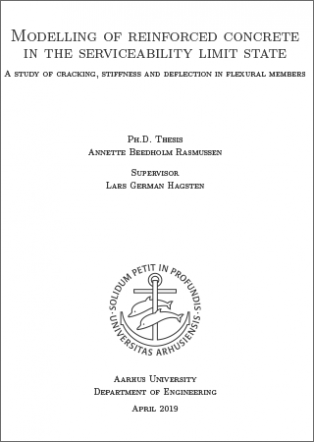Modelling of reinforced concrete in the serviceability limit state: A study of cracking, stiffness and deflection in flexural members
Nøgleord:
concrete, reinforced concrete, cracks, tension-stiffening, deformation, serviceability limit state, crack spacing, crack width, stiffness, cracking, deflectionSynopsis
The objective of the present thesis is to advance the understanding of the behaviour related to cracking in reinforced concrete, as well as improve modelling of flexural members in the serviceability limit state. This should create a stronger connection between modelling of the two limit states of design, and lead to better utilisation of both concrete and reinforcement.
One of the main issues within the subject of reinforced concrete in the serviceability limit state, addressed in this thesis, is that focus has for many years primarily been on investigations concerning the ultimate limit state. Research within the serviceability limit state thus lags behind, where models lack physical transparency and are merely conservative estimates. Furthermore, the different aspects of the serviceability limit state, namely the estimation of crack widths, stiffness, and deformation are not coherently modelled with a general way of interpreting the physical behaviour. This particularly concerns the effect of tension-stiffening on the flexural stiffness, which is addressed empirically or sometimes even ignored.
The thesis proposes an approach to evaluate all the important aspects of the serviceability limit state which was developed from one requirement; that both crack widths, flexural stiffness, and deflection, can be estimated from coherent physical considerations of how flexural members behave, analogue to the models for designing reinforced concrete in the ultimate limit state. This requirement resulted in an approach based on the knowledge of one single parameter; the crack spacing. The approach assumes that all deformation takes place solely in the cracks, which means that crack widths can be estimated from the crack spacing and the mean strain in the reinforcement.
Since the crack spacing is the foundation of the entire approach, it was considered crucial to gain as much knowledge as possible about this parameter. This is achieved, firstly, through a thorough literature review and, secondly, a comprehensive empirical study of crack spacings in 142 tensile tests and 462 flexural tests from the literature which are treated statistically. To minimise the influence of the randomness associated with cracking in concrete, a large amount of data was required. From the ambition of establishing a database of comparable data and to avoid subjectivity, all crack spacings have been collected in the same manner; by consistently measuring them from photos of the crack patterns.
For regression analysis of the crack spacings, the beams are grouped into two categories; laboratory beams, smaller than 300mm in effective depth, and structural beams, larger than 300mm. From both the empirical study and the results of a series of conducted tests, the two categories are observed to behave differently with respect to the crack patterns and crack spacings. Both categories of beams are analysed with respect to two different types of cracks; the secondary cracks and the primary cracks which individual crack spacings are measured at the level of the reinforcement and at mid-height of the members, respectively. The results of the regression analysis showed that only one type of crack develops in the laboratory beams with a spacing controlled primarily by the bond parameter; phi_s/rho_s. However, a large random scatter is associated with the crack spacing in laboratory beams, whereas the conclusions for the structural beams is much clearer. In these beams, the primary crack spacing is found to be linearly proportional to the effective depth, while the secondary crack spacing showed dependency on both the cover and the phi_s/rho_s-ratio. Nevertheless, these two parameters are found to largely describe the same variation in the crack spacing and their relation is therefore investigated further.
The proposed approach is seen to agree well with the test results of beams subjected to four-point-bending as well as it shows slightly better results than the Eurocode model for predicting deflections. From these positive results of the approach, a potential for future studies is seen in using the same fundamental assumptions for modelling other aspects of the behaviour of reinforced concrete.

